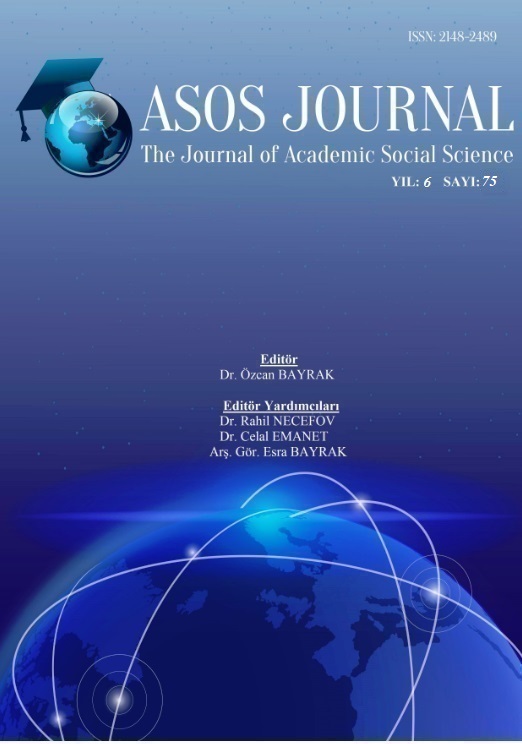Author :
Abstract
Günümüzde ödeme sistemleri ve araçları yaygınlaşmaktadır. Öyle ki sadece alışverişlerde değil giderek genişleyen kurum ödemeleri, toplu ulaşım ödemeleri, yiyecek-içecek otomatlarına yapılan ödemeler gibi geniş bir ödeme alanında nakit kullanımı gerektirmeyen ödeme araçları kullanılmaktadır. Bu ödeme araçlarının başında ise temassız işlem özelliği, uzaktan ödeme, çevrimiçi ödeme gibi imkânlar sunan kredi kartları gelmektedir. Bankaların şube ağlarının yaygınlaşmasıyla finansmana kolay ulaşım imkânının artması, kullanıcıları yeni finansal ürünleri kullanmaya ve gelecekte beklenen geliri bugünden tüketmeye motive etmektedir. Araştırmamızda istatistiksel analiz yöntemlerinden olan independent simple t-testi, tek yönlü anova, Kruskal-wallis, faktör analizi yöntemleri uygulanmıştır. Kredi kartlarının kullanıcılar tarafından bir finansman biçimi olarak algılandığı ve kredi kartlarının tahsilat açısından birinci öncelik olduğu tespit edilmiştir.
Keywords
Abstract
Today, payment systems and tools are becoming widespread. It is not only shopping but also payment instruments which do not require cash usage in a wide payment area such as increasing institutional payments, public transportation payments, payments for food and beverage vending machines are used. At the top of these payment instruments are credit cards that offer contactless transaction features, remote payment, online payment, and so on. With the expansion of the branch networks of the banks, the increase in the possibility of easy access to finance motivates the users to use new financial products and to consume future expected income in the future. Independent simple t-test, one-way anova, Kruskal-wallis, factor analysis methods were used in our study. It has been determined that credit cards are perceived by users as a form of financing and that credit cards are the top priority for collection.
Keywords
- Akgüç, Öztin. Kredi taleplerinin değerlendirilmesi. Arayış Basım ve Yayıncılık, 2011. s.395-
- Apak, Sudi; Yılmaz, Güneş. Finansal Kriz Döneminde Türkiye'de Kredi Kartlari. Muhasebe ve Finansman Dergisi, 2009, 44.
- Banka ve Kredi Kartları Kanunu, 2006, T.C Resmi Gazete, 26095, 01.03.2006, Madde 3/e
- Barboza, G. (2018). I Will Pay Tomorrow, or Maybe the Day After. Credit Card Repayment, Present Biased and Procrastination. Economic Notes: Review of Banking, Finance and Monetary Economics, 47(2-3), 455-494.
- Başaran, Bülent; BUDAK, Gamze Sancar; Yılmaz, Hüseyin. Kredi Kartlarının Rasyonel Kulla- nımını Etkileyen Bireysel Faktörler. Eskişehir Osmangazi Üniversitesi İktisadi ve İdari Bilimler Dergisi, 2012, 7.2.
- Çavuş, Mustafa Fedai. "Bireysel Finansmanın Temininde Kredikartları: Türkiye’de Kredikartı Kullanımı Üzerine Bir Araştırma." Selçuk Üniversitesi Sosyal Bilimler Enstitüsü Dergisi 15 (2006): 173-187.
- Elliehausen, Gregory, SİMONA M. Hannon. "The Credit Card Act and consumer finance com- pany lending." Journal of Financial Intermediation 34 (2018): 109-119.
- Girginer, Nuray; Çelik, Arzum Erken; Uçkun, Nurullah. Eskişehir Osmangazi Üniversitesi İkti- sadi Ve İdari Bilimler Fakültesi Öğrencilerinin Kredi Kartı Kullanımlarına Yönelik Bir Araştırma. Anadolu University Journal of Social Sciences, 2008, 8.1.
- Güngör, Nazan; ÖNDEŞ, Turan, "Kobi’lerin Finansmanı Erzurum Organize Sanayi Bölgesinde Bir Araştırma." Atatürk Üniversitesi İktisadi ve İdari Bilimler Dergisi 27.1 (2013).
- Joewono, T. B. ; Effendi, B. A. ; Gultom, H. S., Rajagukguk, R. P. (2017). Influence of Personal Banking Behaviour on the Usage of the Electronic Card for Toll Road Payment. Transportation research procedia, 25, 4454-4471.
- Kalaycı, F. Özden. Bankacılık açısından kredi kartları sisteminin işleyişi ve bir örnek uygulama. (Yüksek Lisans Tezi) Selçuk Üniversitesi Sosyal Bilimler Enstitüsü, 2003. ,s.17
- Kalaycı, Şeref. SPSS uygulamalı çok değişkenli istatistik teknikleri. Ankara, Turkey: Asil Ya- yın Dağıtım, 2010.
- Karakulle, İsmail; TAN, Fatma Zehra "Finansal Okuryazarlık İle Kredi Kartı Tutumu Arasında- ki İlişkinin İncelenmesi: Üniversite Öğrencileri Üzerine Bir Araştırma ", Akademik Sosyal Araştırmalar Dergisi, Yıl: 6, Sayı: 69, Nisan 2018, s. 461-477.
- Karakurt, Alper, “Kredi Kartları Pazarında Çok Markalılık Ve Rekabet: Rekabet Kurulu Karar- ları Işığında Pazar Analizi”, Rekabet Dergisi, 2009, 10(1): 55-79.
- Kaya, Ferudun. Türkiye'de kredi kartı uygulaması. Türkiye Bankalar Birliği, 2009.
- Oktay, Erkan; Özen, Üstün; Alkan, Ömer. Kredi Kartı Sahipliğinde Etkili Olan Faktörlerin Araştırılması: Erzurum Örneği. Dokuz Eylül Üniversitesi İktisadi ve İdari Bilimler Fakültesi Dergisi, 2013, 24.2, ss.1-22.
- Özkul, Fatma Ulucan; Tapşın, Gülçin. Kredi Karti Kullanimi ile Kullanilabilir Gelirin Tüketim Üzerindeki Etkisi ve Türkiye Ekonomisi Üzerine Bir Ampirik Çalisma. Muhasebe ve Finansman Dergisi, 2010, 47.
- Parasız, İlker. "Para Banka ve Finansal Piyasalar, Ezgi Kitabevi Yayınları, 7." Baskı, Ocak (2000).
- Tbb, Banka Kartları ve Kredi Kartları Uygulamaları Hakkında Yararlı Bilgiler, Yayın No:257, TBB, İstanbul 2008.
- Tekşen, Ömer; BEKCİ, İsmail. Bankaların Kredi Kartı Puan Uygulamaları Ve Muhasebeleşti- rilmesi. 2010.
- Tuğay, Osman; BAŞGÜL, Nermin. Önemli Bir Finansman Kaynağı Olarak Kredi Kartları: Kredi Kartlarının Kart Sahiplerinin Harcamaları Üzerindeki Etkisini Belirlemeye Yönelik Burdur İlinde Bir Araştırma. Süleyman Demirel Üniversitesi İktisadi ve İdari Bilimler Fakültesi Dergisi, 2007, 12.3.
- Yıldırım, Figen ‘’Bireysel Kredi Kartları ve Tüketici Davranışı’’, Türkmen Kitabevi 2013.
- Yılmaz, Hüseyin; Budak, Gamze Sancar; Başaran, Bülent. Kredi Kartı Kullanım Alışkanlıkla- rında Kategorik Değişkenler Arasındaki İlişkiler ve Bireylerin Davranışsal Eğilimleri: Bilecik Örneği. Uluslararası Yönetim İktisat ve İşletme Dergisi, 2013, 9.19: 31-49.





